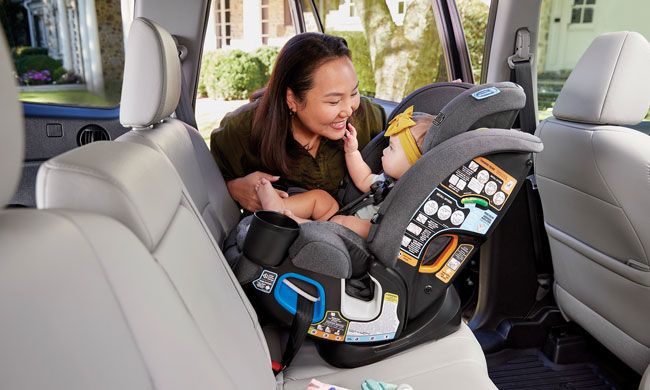In the realm of parenthood, few acquisitions carry the gravity of selecting the right car seat for your offspring. The importance lies in the meticulous matching of this automotive accessory with both your child’s specifics and the dimensions of your vehicle. According to statistics from the Centers for Disease Control and Prevention, vehicular accidents rank as a prominent cause of fatality for children aged 12 and below.
As your progeny undergoes the metamorphosis of growth, you’ll find yourself in the inevitable situation of modifying their vehicular seating arrangement to accommodate their evolving stature and weight. Child restraint systems consist of four designated stages: the rear-facing harness, forward-facing harness, belt-positioning booster seat, and ultimately, the regular seat belt. These stages vary in their offerings, with each catering to distinct requirements presented by your child’s development.
For instance, consider the Graco 4Ever DLX Grad 5-in-1 Car Seat—a trailblazing innovation in the realm of automotive safety. This groundbreaking seat ushers in an era of extended utility and value, marked by a design oriented towards the comfort and security of children ranging from 4 to 120 pounds, spanning up to 12 years of age. The car seat boasts a quintet of operational modes, covering the rear-facing harness, forward-facing harness, both high-back and backless boosters, and an easily detachable seat belt training feature. Additional amenities encompass a space-efficient slender build, SnugLock technology facilitating swift and effortless installation, a 10-position adjustable headrest and harness, detachable inserts, and swiveling cupholders.
To make an astute selection with your child’s safety as the foremost concern, Graco has meticulously curated a guide, segmenting the process into stages in accordance with the recommendations issued by the American Academy of Pediatrics and the National Highway Traffic Safety Administration.
Stage 1: Rear-Facing Harness In consonance with guidance from the American Academy of Pediatrics, the counsel is to perpetuate the use of a rear-facing car seat in the rear compartment of your vehicle for as long as practical. This practice should continue until your child attains the predetermined weight or height threshold stipulated for the car seat, thereby optimizing their protection during vehicular journeys.
While it is common for parents to usher their newborns home from the hospital ensconced in an infant carrier—a portable seat equipped with a dedicated stay-in-vehicle base tailored to the unique needs of newborns and infants—it is worth noting that alternatives exist. Convertible seats and all-in-one configurations offer higher weight tolerances than infant carriers, thus facilitating the continuance of the rear-facing orientation up to the point where the child’s weight reaches the 40-50 pound range.
Stage 2: Forward-Facing Harness Upon surpassing the prescribed limits of their rear-facing car seats, the transition entails fastening your child into a forward-facing car seat, complete with a harness and an upper anchoring tether, within the rear section of the vehicle. This arrangement should persist until your child attains the maximum height or weight specification indicated for the seat, which typically aligns with the ages of 5 to 6.
Stage 3: Belt-Positioning Booster Seats Subsequent to outgrowing their forward-facing car seats equipped with harnesses, the next logical step involves securing your child in a high-back belt-positioning booster seat, suitable for those weighing between 40 and 100 pounds. These booster seats provide supplementary neck and head support. As your child progresses, a backless belt-positioning booster seat, designed for individuals in the 40-120 pound range, becomes the next stage in the sequence. It serves to ensure that the vehicle’s seat belt assumes the proper positioning across your child’s lap and shoulder region, obviating the need for a booster seat. This developmental milestone typically occurs between the ages of 9 and 12.
Stage 4: Seat Belt An intriguing insight gleaned from Ipsos’ survey data indicates that roughly 31% of parents transition their offspring directly from a high-back booster to the standard vehicle seat belt. To navigate this transition safely, many children require guidance with regard to the seat belt’s positioning. This is where the versatile 4Ever DLX Grad 5-in-1 Car Seat with its detachable Seat Belt Trainer comes into play. It effectively aids in aligning the seat belt correctly, extending the period during which children can travel with enhanced safety while still enjoying the sensation of growing up.
Upon reaching the point where the seat belt fits snugly and securely, children can dispense with the booster seat. This signifies that they can situate themselves comfortably against the vehicle’s seat, with knees slightly bent at the seat’s edge, the lap belt resting low on their hips and upper thighs—avoiding contact with the stomach. The shoulder belt should be positioned to traverse the collarbone and sit flush against the torso. In this configuration, they can remain seated comfortably for the duration of the journey.
For additional information and assistance in selecting the ideal car seat tailored to your child’s unique requirements, kindly visit gracobaby.com.



